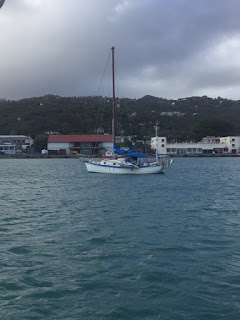The combined wild life reserves of Hluhluwe (pronounced Shishluwee) and Imfolozi, are about the size of a small country, covering 96,000 hectares of bushland. Being only 80 miles north of the marina at Richards Bay, they are the closest parks and easiest to access in a self drive hire car.
I didn't want to go on my own, so asked the American father and son off the 27' yacht "Beguine" (who had helped with my damaged rigging back in Rodrigues) to join me, sharing costs of hire car etc.
I was the designated left hand driver, and they were my eyes as we crawled slowly along hundreds of miles of dirt tracks, looking this way and that, one of them occasionally calling "Stop!, back up, there! See it? A white rhino".
 |
| The white Rhino isn't actually white, but has some distinguishing features as well as a dusting of icing on its back. |
Unbelievably, these huge creatures, bigger than a truck, can move a few feet, stand stock still behind a spindly patch of twigs and simply disappear from sight. So you have to move slowly, stop often and be patient.
Then suddenly a 20' tall giraffe is standing in the middle of the road -
Then suddenly a 20' tall giraffe is standing in the middle of the road -
then a mountain-sized elephant.
Totally surreal, almost as if sculptures in a Disneyland theme park, until they move.
I was blown away by just how ginormous these animals are up close, out in the open. At times I felt a little nervous, especially when they started walking our way.
We saw nearly all the Big 5 - the elephant, the rhino, (both, white and black), the water buffalo, the lion. Only missed out on the leopard, but we did see a leopard tortoise.
 |
| A pride of lions, mother, father and cubs lazing about in the clearing. Binocs necessary to get a close up view. About as close as I would want to be. |
There were heaps of other impressive animals -
 |
| This zebra stood in the middle of the road, stamping his hind leg. Only after we passed did we notice he had no tail (most probably a snack for a lion), so was just keeping flies (not us) away. |
- wart hogs, impalas, wildebeests, baboons, hippos and Nile River crocs -
 |
| The two hippos on the left were about to fight (apparently to the death) over a female. |
 |
| These delicate, frisky little Impalas were everywhere. I love the way they kick up their hind legs when bounding away. |
The Beguine guys were seasoned bird watchers and spotted many vultures, eagles, buzzards, kingfishers and others. Again, binocular viewing only for the really big birds in the treetops.
The cost of the three day excursion was very inexpensive, with the hire car being only $AU20 a day. Accommodation in the nearby town of St Lucia (where we took the hippo and croc boat) was about $AU20 each for a two bedroomed self catered apartment.
The cost of the three day excursion was very inexpensive, with the hire car being only $AU20 a day. Accommodation in the nearby town of St Lucia (where we took the hippo and croc boat) was about $AU20 each for a two bedroomed self catered apartment.
On the second night, we rented two twin bed chalets at $100 each inside the reserve, a bit more costly but well worth it.
The Mpila camp in the southern Imfolozi reserve is unfenced, so animals can wander freely through at night. Whoa. Didn't see any but heard plenty of velvet monkeys, baboons, and bigger?
We could have booked a tour jeep for minimal extra expense, but I think doing our own "hunting" was better. I can just imagine bumping along on the bench seats in the back of one of these vehicles, amongst several other tourists. The tour guides use drones to find the animals, would drive you straight to them, stop a minute, saying, "there's a rhino"; "there's an elephant" etc. before moving on to the next. Where's the challenge in that?
Giraffe equivalent of a lolly-pop man at a school crossing; standing in the middle of the road while several smaller ones ambled slowly across.






























